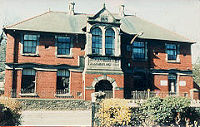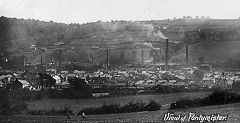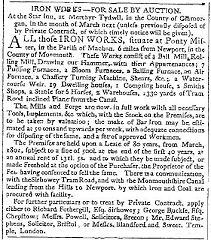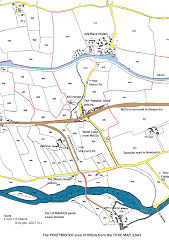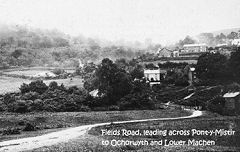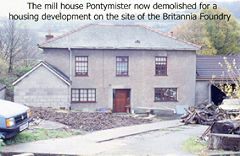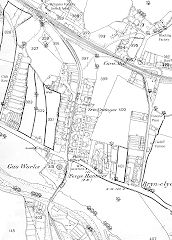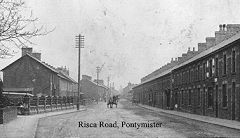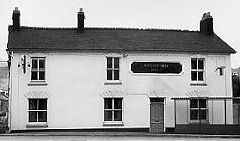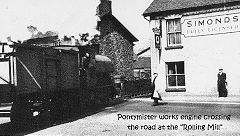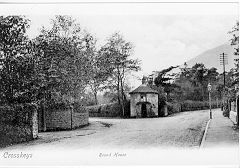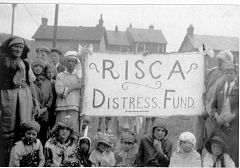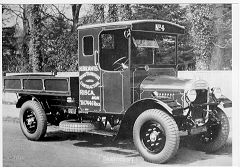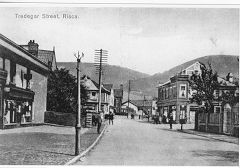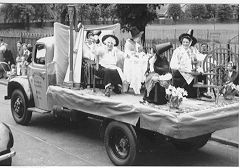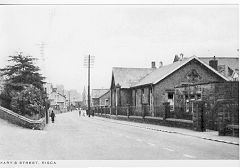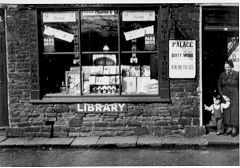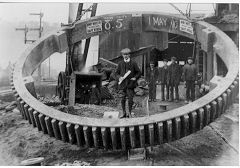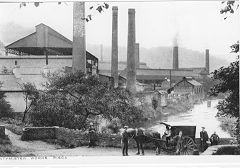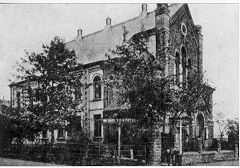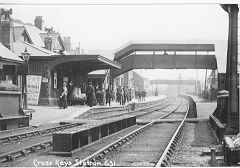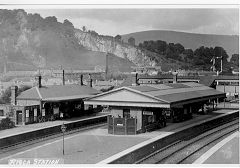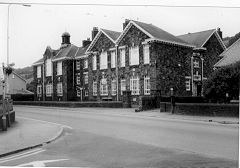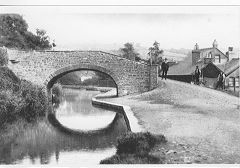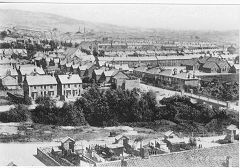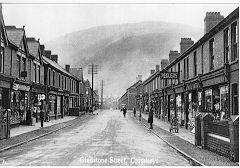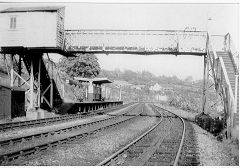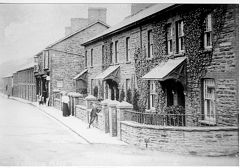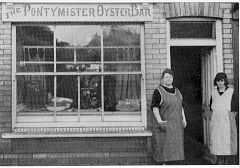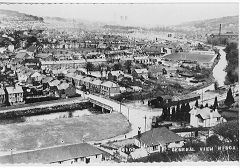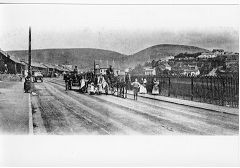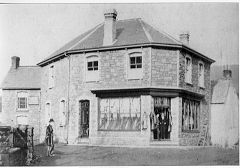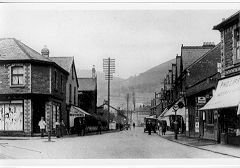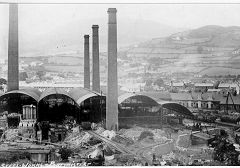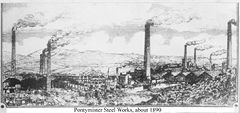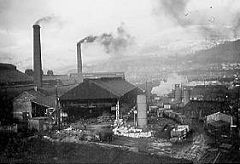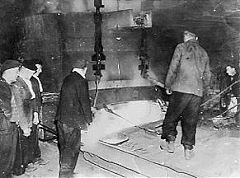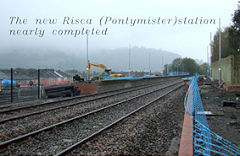The Development of Risca and Pontymister
Social and religious roots
In the late 18th Century, on his first journey into Monmouthshire, Archdeacon William Coxe recorded that he approached Risca from the north from Abercarn on horseback,
"Following the course of the Ebwy at a little distance from its banks, where it loses itself in an abyss of trees and flows under the deep side of Machen Hill, heard but not seen. I reached Risca, a village situated at the extremity of the vale and under the precipitous crags of Twym Barlwm"
The parish of Risca lies in the Ebbw valley, between Mynydd Maen, its highest point being Twmn Barlwm hill with its Iron Age hill fort and motte, visible from miles away, and the parish of Henllys to the east, and Mynydd Machen, with a television repeater mast, in the parish of Machen to the west. Risca adjoins parishes of Bassaleg to the south and Mynyddislwyn to the north. The perpetual curate of Risca was appointed by the rector of Bassaleg, where the curate lived and no doubt officiated for a great part of his time. The Bishops Transcripts start from 1696, and can be viewed on microfiche at the National Library of Wales, Aberystwyth. The parish registers are held at the Gwent Records Office; registers of baptism and burial, prior to 1813, have been lost, but the marriage registers date from 1754. Risca was in the Hundred of Wentloog, the rural deanery of Newport, the archdeaconry of Monmouth and the diocese of Llandaff. It was in the petty sessional division, union and county court district of Newport.
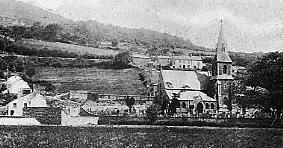
The ruinous old church was demolished in 1853 and a new church was built on the old site, and dedicated to St. Mary. The early history of the area is obscure, but, during the excavations prior to the rebuilding of the church, evidence was found of a previous Roman occupation - structural remains of a Roman wall and a tiled floor. The tiles were stamped with the mark of the Second Augustan Legion, LEG II AVG, based at Caerleon. Some historians have averred that Twmbarlwm was a Roman signalling station, as it is easily visible from their camps at Caerleon and Gelligaer.
The origin of the name Risca is uncertain. There are two other known uses of the name, Nant Risca, was the name of a brook that flows through Abertridwr and there is a Cwm Risca near Tondu in Glamorgan. The district of Crosskeys in the north of the parish took its name from a public house that was built alongside the tramroad to Crumlin and Abercarn in about 1828. Pontywain, the Gwentian Welsh pronunciation of Pontywaun. Pontymister, in the south end of the parish, is the name of the old stone bridge crossing the Ebbw River and linking Risca with Lower Machen, and the name taken by the adjacent farms. Charles Phillips of Marshfield acquired Risca House and its estate in 1745 when he married Amy Walters. Their son William Phillips inherited the house and became known as 'Squire Phillips' According to the oft-repeated tale, when he fell in love with a certain lady on the other side of the Ebbw River, he had a stone bridge constructed to assist his courtship and it became known as 'Pont-y-mister; meaning 'The master's bridge'. The Squire was an imposing man of 6ft 4in, and is said to have fathered 26 children. The most likely origin of the name is Pont-y-mwystwr, the monastery bridge, as in medieval times there was a grange or monastic farm of Llantarnam abbey in the area. The Pilgrims route from the abbey to the shrine at Penrhys, high above the Rhondda valley, passed through here. That he fathered 26 children by one wife may well be true, as the Cambrian newspaper of 9th December 1809 contained the following announcement.
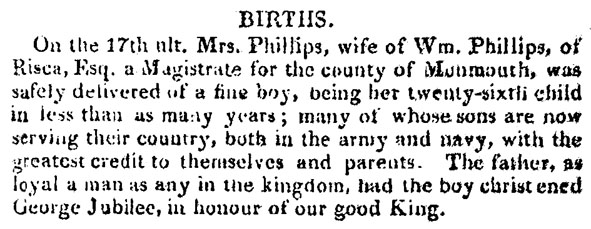
In 1801, the parish of Risca had a population of only 240. The village of Risca consisted of the church, a public house known as the 'Church House Inn', later rebuilt and named the 'Darran' and a few cottages nearby, and a scattering of cottages and farms throughout the parish. The area would have been essentially rural until the industrial revolution brought in workers from far and wide to satisfy the needs of the new coal mines, ironworks and other industries, and their attendant tramroads. Coxe observed
"Between Newbridge and Risca, numerous houses, mills, forges and hamlets are scattered on the sides of the canal, and on the banks of the Ebwy, and the whole valley becomes a scene of bustle and activity"
By 1891 the population of Risca had risen to 5,647.
Glyn Congregational Church
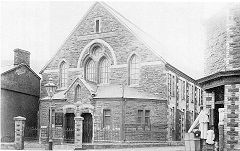
Glyn Congregational Church
The early congregation of this church met in a barn which was an outbuilding of Cwmnant Farm once located close to the former Risca Brewery. The first Glyn Church was built in 1858 and was known locally as Capel y Glyn (the church in the valley) the original Pastor was Evan Evans, formerly of Nant-y-glo.
Services were conducted partially in Welsh up to 1873 from which date services were conducted in English. The early congregation was never strong but by 1890 their generosity cleared the debt of the old chapel. Unfortunately in 1892 a storm collapsed the church roof resulting in a reconstructed church seating about 650 people and at a cost of £1,200. A new schoolroom was added in 1909 which accommodated 400 at a cost of £600 Reverend J T Phillips was Minister from 1908 until 1948. In 1972 Glyn became part of a United Reform Church comprising a partnership of Congregationalists, Methodists and Presbyterians. The Chapel was eventually demolished and was replaced by a modern red-brick building on the corner of Tredgar Street and Dan-y-graig Road.
Industry and Transport
Coal mining had been carried on high up on Machen Mountain, in Waunfawr, which was a 20 acre enclosure where the coal measures outcrop, since at least 1670, and probably also in the Darran. However, all this work was almost certainly carried on in the winter months by a small number of men who lived in cottages scattered over the mountain to provide house coal. A lack of good roads to transport the coal was one of the difficulties in the way of developing these coal works.
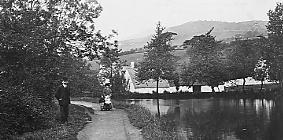
The canal was built from Crumlin towards Rogerstone, to connect with the line of canal from Newport to Pontypool. Tramroads from the ironworks at Ebbw Vale and Nantyglo were built to the canal at Crumlin basin, where the iron was transhipped into canal boats. The canal was open from Crumlin, through Risca, to Rogerstone by late 1794, but it took until 1799 to complete the building of the flight of 14 locks at Cefn, before boats on the canal at Risca could travel through to Newport. This photograph shows the canal passing Risca House, the home of the Phillips family of Pontymister from 1745, but now demolished to build houses.
Edward Jones took a lease of the Waunfawr coal in 1796 and built a tramroad across the valley from his coal workings to the canal, where the Green Meadow Inn was later built. Passing through Risca in 1799, William Coxe paused to observe the working of the incline. He said:
"On my way to Risca, I crossed a bridge over a rail road, lately formed by Mr Edward Jones, who rents under Mr Morgan of Ruperra some mines of lead, calamine, and coal, in Machen Hill, on the opposite side of the Ebwy. The expedition and security, with which the cars are conveyed up and down the steep side of the precipice, appear singular to a spectator on the bridge. Two parallel rail roads are carried from the canal to the opposite side of the Ebwy, along which two cars are drawn up and let down at the same time by means of an engine; they appear to pass each other alternately, like buckets in a well; a boy descends with the empty car, nearly midway, and after adjusting the machinery is again drawn up with the loaded car, which empties the coals into the boats of the canal"
The railroad was probably an iron plateway rather than of edge rails or wooden construction. A number of houses were built around the pit, on the Machen side of the river, of which only foundations now remain. These small houses, tightly clustered, were known as the Rookery. There was a pub, a shop and a chapel.
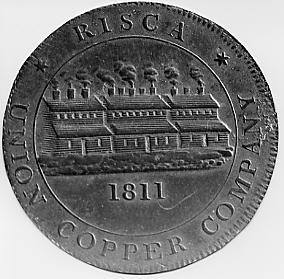
The Union Copper Companys' works at Danygraig was started in 1807, and was actually on the Machen side of the Ebbw River, in Lower Machen. It made use of cheap small coal from the Waunfawr Colliery, which was otherwise only of use in lime-burning kilns. A number of cottages were built around the copper works, again on the Machen side of the river. In 1811 the company issued its own copper tokens. The copper works closed in 1816, becoming the site of David Morris' chemical works.
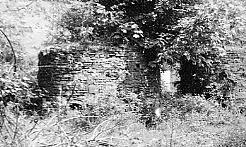
The chemical works became Southwood Jones' Danygraig brickworks in 1895. There is still a brickworks on the site today, making concrete bricks rather than firebricks. Once there were five firebrick works around Risca, three in the Darran (the beehive kilns at Jones' Darran Firebrick Works pictured here), the Danygraig works, and Russell's brickworks near the Blackvein colliery, which became the Star brickworks.
The Sirhowy tramroad was built from the ironworks at Sirhowy and Tredegar to join the Monmouthshire Canal Company's tramroad from Newport, which had been built to the nine-mile point. Under their Act of Parliament, the canal company could build a tramroad to any point eight miles from their canal. As Sir Charles Morgan of Tredegar agreed to build one mile of the tramroad through his Tredegar Park, which literally become his ԧolden mileԬ the Monmouthshire Company added this mile to their permitted eight and built to a point nine miles from Newport. Near this spot the Penllwyn Tramroad joined, bringing coal from mines on the east bank of the Sirhowy River up to near Blackwood. In 1902 the first portion of this tramroad was used to access the site of a new deep mine, which came to be called Nine Mile Point colliery. In the early days of tramroads, wagons were horse drawn. Each wagon carried a maximum of three tons, later to be reduced to a maximum weight of three tons including the wagon. Private-owned steam engines began to be used in 1831.
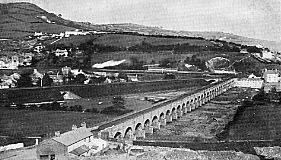
The 32-arch long bridge across the valley at Risca was completed late in 1805. This view shows the long bridge with the Bridge End Inn, built and run by Edward Duffield, at its eastern end. The tramroad was extended northwards up the valley from the east end of the long bridge to Crosskeys, Abercarn and Crumlin, where it joined the existing tramroad from the ironworks in 1828. Usage of the canal decreased after this date. With the coming of the railway era the long bridge was superseded by a railway embankment, eliminating the sharp curves at each end of the bridge, and demolished in 1905, having stood for 100 years. The stone was used to build the houses in Bridge Street, Risca, and the surrounding area. The Bridge End Inn, once the stopping point for hauliers and their horses, still stands alongside the railway high above the main road, but is now a private house.
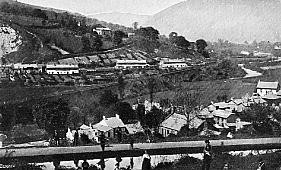
A community grew up around the west end of the long bridge to house the families of those working in the copper works and the later chemical works. The owners of the copper works were negotiating to build houses under the 32 arches of the long bridge, but nothing came of this. This picture shows the copperworks houses just to the north of the west end of the long bridge (out of picture), Danygraig House on the hillside above them , built by David Morris, owner of the later chemical works, and the railway embankment which replaced the long bridge. In the houses on the immediate left of the picture was the Sugar Loaf public house. All these houses and the railway embankment and viaduct have now been demolished. In the centre foreground below the canal is the Wesleyan Methodist chapel, now a Coptic Christian church, with the roof of Dr Robathan's house, the Grove, now Oxford House, showing in the trees behind it. People also used the tramroad as access to their houses that they had built alongside the tramroad. The main road through the middle of both Fleur de Lys and Blackwood were once tramroads. This also happened in Risca. Houses were built alongside the tramroad to Newport, especially around the Masons' Arms in Pontymister. The same happened after 1828, when the tramroad was extended northwards from the east end of the long bridge to Crosskeys and Crumlin. The tramroad was a better means of travel than the turnpike and parish roads. It was well-metalled and well-maintained. People used the tramroad to get to market in Newport. Many people were badly injured or killed by falling under the wheels of the wagons when attempting to climb on or off moving wagons. The Chartists marched on Newport in 1839 along the tramroad. Adjacent to the church was the Yew Tree Inn where the landlord John Walker, who was also the church sexton, locked himself in with some friends to avoid being conscripted by the Chartists. Another public house on the south boundary of the parish and adjacent to the Tramroad, the 'Welsh Oak' was another gathering place.
When the Monmouthshire Canal Company obtained an Act of Parliament in 1849 to convert their tramroads into proper railways, doing away with haulage by privately owned engines and horses (both using the same track at the same time!), they had to provide a safe means of access to these houses. These paths and roads parallel to the railway can be walked to this day. From St Mary's Church, there is a path alongside the west side of the railway to the road at the premises of 'Risca Builders'. There is a road leading to Penrhiw on the opposite side. At the end of the long bridge, where the abutment wall remains, a flight of steps to the front of the former Bridge End Inn, which was built facing the former tramroad from whence its customers came, and down the old lane to join the road at the rear of Moriah chapel. The road keeps parallel with the railway past Gelli Road, and then along a back lane until you come to Mill Road. A twisting underpass replaced the old crossing at Mill Road. From the Masons' Arms on the other side, another road follows the former tramroad southwards.
After John Russell and his partners acquired the Blackvein colliery in 1839, some development took place around the church. The now-demolished Albert Hotel was built as a commercial hotel in 1840 for this growing colliery district. Russell sunk another shaft in 1841 further to the north of the earlier shaft, which became known as the 'Old Ventilator' shaft. One of the coals worked was the Black vein seam, a valuable coal for steam raising but notoriously gassy. The colliery drew many people from Somerset, Dorset, Gloucester and Wiltshire for work.
George Randall Hookey, one of the proprietors of Risca colliery, said in evidence to the commissioners enquiring into the employment of children in mines in 1842
"In working the narrow seams we are compelled to use the labour of children as men are too large for the work, and, from the necessity of the case, lads from 11-15 years of age are employed to draw with the girdle and chain; distances not exceeding 300 yards, the weight drawn from 50 lb to 1 cwt. Very young children are of no service to us, as their strength is insufficient; they rarely commence until 10 years of age"
Mr Samuel Hill, agent, said
"The larger proportion of our colliers are Kingswood men, and are in the lowest depth of ignorance; and from my experience and observations I consider the rising worse than the present generation. Welsh colliers will not draw with the girdle and chain"
Risca Colliery employed 250 adults, 50 youths under 18 years of age, and 15 boys under 13 years of age, in 1842. Unfortunately, as with most other collieries, several explosions occurred at the Risca Black Vein pit. The valuable steam-raising coal, the Blackvein seam, was notoriously gassy. After safety inspection by the firemen it was custom to work with naked lights, and, needless to say, there were many explosions over the years :-
- 5th November 1842: 2 men killed, 4 burnt
- 1st December 1842: 3 men killed, 6 burnt
- 10th January 1846: 35 men and boys killed, 6 burnt
- 1849: 2 men killed
- 11th March 1853: 11 men and boys killed, 10 injured
- 1st December 1860: 142 men and boys killed
Although the use of naked lights in the Blackvein pit had been banned, only a week before this dreadful explosion and loss of life, a collier was convicted and fined by local magistrates for using a naked light underground in breach of regulations. The Risca Colliery Company was bankrupted by the explosion and the cost of a lost legal battle over encroachment on other coal of Lord Tredegar not in their lease, and was eventually taken over by T.W. Rhodes. It was eventually repaired and put back in work. Edmund Hannay Watts, William Milburn and Edward Stout, trading as the London and South Wales Coal Company, purchased Rhodes' interests in 1872. By then the workings extended far from the shaft and it was decided to sink new shafts. Work on the new pit started in 1875, and the Black Vein coal was finally met at a depth of 280 yards. Full production started in July 1878 and the old Blackvein shaft was used only for ventilation.
The new pit was actually in the parish of Mynyddislwyn and was eventually known as North Risca Colliery. A new town was built near this pit for the miners who were to work there, Newtown, and now part of Crosskeys. Wattsville grew to provide more housing. Just two years later, in July 1880, a gas explosion killed 120 men and boys, the entire night repairing shift. This followed the disastrous explosion and fire in the Prince of Wales colliery at Abercarn, a few miles up the Ebbw valley, in 1878, also working the black vein coal, when 256 men and boys were killed and the canal was eventually drained into the pit to put out the fire. The last explosion occurred on Sunday 15th January 1882, when 4 men were killed in the new pit. Although explosions made the headlines, many men were killed or maimed underground in frequent accidents involving falls of roof or coal, shaft accidents, etc. In 1892, United National Collieries Ltd was formed to take over the Risca, Abercarn and other collieries managed by Watts, Ward and Company.
Education
The Risca Town British system school opened in March 1850. Land was donated by John Arthur Herbert for the purpose. Workmen at Pontymister volunteered deductions from their wages to help raise £550, of which the building cost £400. The committee comprised Thomas Lewis of the Pontymister works, chairman, Ebenezer Rogers, manager of the Abercarn colliery, William Matthew and Thomas Cross, brewers and maltsters in Risca, John Evans, E. Edmunds, David Nurse and David Benjamin. Although closed in 1853 due to the lack of a qualified schoolteacher, this was the only school in the Risca area. Children living in Ochyrwyth, the Copper works and Blackvein colliery area were expected to attend the church school, opposite the church in Lower Machen. Following the passing of the 1870 Education Act a meeting at the school in December 1871 led to the formation of the Risca School Board. The rector of Machen, the Rev. Augustus Morgan, youngest brother of Lord Tredegar, successfully opposed the setting up of a school board in Machen. He wanted all children in his parish to attend the church school in Lower Machen and two new schools which he intended to build. One of these was the Waunfawr school, next to the Blackvein pit, but on the Lower Machen side of the river The Risca School Board opened the Pontymister schools (boys and girls junior, and infants) in 1877 to cater for 400 pupils and the Crosskeys schools (joint board schools with Mynyddislwyn) in 1880 for 500 pupils. The Education Department eventually ordered Machen parish to pay towards the education of children from Ochyrwyth and the copperworks at the Pontymister school, as it was deemed too far to travel to Machen school. The New Waunfawr and Danygraig schools were eventually opened in September 1893. A Catholic school, built alongside the R.C. church to cater for the growing Irish population in 1870, had 60 pupils in 1891.
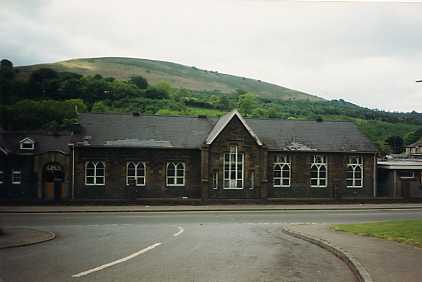
After the passing of the 1889 Welsh Intermediate Act a board of governors was set up to administer the Pontywaun School District, which stretched from Newbridge to Rogerstone, and included Machen, to secure a site for a new secondary school. The Pontywaun County School (the 'grammar school') opened in May 1900 on a site in Pontymister, by the Commercial Inn.
Risca Urban District Council was formed in 1878 of Risca parish and those parts of Upper and Lower Machen from the Ebbw river to the top of Mynydd Machen, to include Ochyrwyth, the copperworks area (Danygraig and the Sugar Loaf), the Risca Blackvein Colliery and its houses, and the Full Moon area, and a little later, that part of Mynyddyslwyn parish where the new pit and Newtown were built. Risca UDC eventually became part of Islwyn Borough Council, and more recent local government re-organisation joined Islwyn and Rhymney Valley borough councils to form Caerphilly County Borough Council.
Risca today
Risca has seen the closure of all its collieries and other heavy industries. At the present time, apart from some light industries, it is in danger of becoming a satellite town for employment opportunities in Newport and Cardiff. However, these communities are proud of their roots and their separate identities - many will say they are from Pontymister or Crosskeys, not Risca! The railway line was re-opened at the beginning of 2008 for passenger traffic from Ebbw Vale, Aberbeeg, Newbridge, Crosskeys, Risca and Rogerstone to Cardiff. The new station in Mill Street by the Masons' Arms is an unmanned halt, in no way comparable with the former Risca Station. When that station was being built in the 1850s the worthy gentlemen and businessmen of Pontymister complained and petitioned that it was in the wrong place and it should be at Mill Street, Pontymister. It has only taken 150 years...
Pontymister iron and Steelworks (Broad's Foundry)
The Pontymister ironworks began in 1801. First it was connected by a tramroad to the canal, but when the tramroad from Newport to Sirhowy was opened in 1805, the ironworks tramroad was connected with the Sirhowy tramroad. In the 1830s much pig iron was received from the Cwm Celyn and Blaina ironworks near the head of the valley and bar iron sent to Newport. All of the various owners of the Pontymister ironworks for the first forty years were in financial difficulties, and most were bankrupted. This sale notice from an 1806 newspaper following the first such bankruptcy reveals that there were 19 workmen's houses within the works site.
The 1843 tithe map of Risca shows that the Pontymister ironworks had not brought growth, housing development and prosperity, in its 40 years existence. What little housing there was had developed along the tramroad.
379-382 Pontymister ironworks, Owner - Sir Charles Morgan (Tredegar Est.), Occupier - John Lewis & Co.
354, 356-359, 376, 378, 389-91, 401, etc Ty Isha, Owner - Sir Charles Morgan (Tredegar Est.), Occupier - William Rosser.
392, 480-482 Duffryn Clyd, Owners - William Treharne Rees and Phillip Rees, Occupier - William Davies.
326-333, 402-406 Ty Mawr (Risca House) (330 Farm buildings 329 House), Owner - Charles Phillips Esq., Occupier - Charles Phillips Esq.
318-325 Ty Mawr Farm, Owner - John Rosser, Occupier - John Rosser.
413-415, 428 Owner - John Rosser, Occupier - Edward Duffield Senior (of Bridge End Inn).
397 Public House, Malt House, etc. Owner - Charles Phillips Esq., Occupiers - Charles Phillips Esq. and William Giles. This is the 'Masons Arms'.
399 Cottages - This is now Mill Row, Owner - Charles Phillips Esq., Occupier - Thomas Cross.
407 Mill House, cottages, etc., Owner - Charles Phillips Esq., Occupiers - Joseph Sottle and Edward Jenkins.
408 Warehouse & cottage, Owner - Charles Phillips Esq., Occupiers - Joseph Sottle and Edward Jenkins. These persons also held from Charles Phillips fields
412 and 429 on which the Pontymister foundry was built, and field
427 through which the works tramroad must have run en route to the canal.
387 The 'Risca House' public house, Owner - William Duffield, Occupier - Daniel Phillips.
388 An adjoining garden held by William Duffield from Mary Thomas.
441a Public house & garden, Occupier - John Phillips. This unidentified public house alongside the tramroad was the 'New Inn', long since demolished.
The land around Duffryn Clyd was held by four different owners, very much split up, under five different tenants.
417 Cottage & garden, Owner - Charles Phillips Esq., Occupier - Edward Duffield Senior (or his under-tenants, as he was owner/occupier of Bridge End, Risca).
431 Cottage, Owner - Charles Phillips Esq. (at entrance to Duffryn Clyd).
442 Cottages & gardens, Owner - Charles Phillips Esq., Occupier - Edward Matthews.
443 Cottage & garden, Owner - Charles Phillips Esq., Occupier - Lewis Edwards.
445 Cottage & garden, Occupier - Thomas Phillips.
416 Cottages & gardens, Owner - Thomas Morris, Occupiers - William Gimlet, Thomas Beard.
Eventually, the works was purchased by the Banks brothers around 1845 and became a tinplate works. They prospered, and Pontymister as we know it today began to grow. Beerhouses, public houses, commercial hotels, shops and houses grew up around the entrance to the works (note some of the names - the Rolling Mill, the Forge Hammer). More development took place along the main road to the north. The Monmouthshire Canal Companyӳ tramroad was converted to a railway in 1850 and the Britannia Foundry opened by Charles Jordan in 1854 alongside the railway line.
Some of this development can be seen on the following OS map of 1883.
P.S. Phillips, owner of the Abertillery tinplate works, purchased the Pontymister tinplate works in 1880, trading as the Pontymister Tin Plate Company. He added a steel works, erected at a cost of ó0,000, to make 1,000 tons of steel per week by the Siemens' process to supply Pontymister and his other works. His wife was the daughter of Edward Robothan of Risca, surgeon, whose house, The Grove, is the present Oxford House. They lived at Crumlin Hall. In June 1891 Congressman William McKinley, later the 25th President of the United States, brought about the imposition of a tariff on imported tinplate to enable the U.S.A. to build up its own tinplate industry. This led to a demand for tinplate at a lower price to compensate for the tariff, all works producing to full capacity, new mills being erected everywhere, and a glut of tinplate. By 1893, the Pontymister tinplate works comprised 12 mills.
The year 1893 was a poor one, dogged by industrial disputes. In the coal industry, this year was marked by a long strike over the Sliding Scale, and brought a lot of industry dependent on coal to a standstill. When this dispute was resolved, Phillips summoned his men back to the steelworks on the proviso that they accepted reductions in wages. This they refused to accept and were locked out. Phillips laid off all the men in the tinplate works related to the steel men, thus cutting off all financial support to the men and their families. To break this deadlock over wages and get the works back in production, Phillips engaged a Scottish strike breaker, Graeme Hunter, to bring in men to operate the steelworks. On Christmas Day 1893, a deputation of two men asked permission of the police to enter the works and talk to the strike breakers, but permission was refused. Incensed by the attitude of the police, stones and clinker were thrown as the men rushed the police lines in an attempt to enter the works. The riot act was read, and a fierce baton charge drove back the men. Twelve men identified as ringleaders were arrested, and committed for trial at the Monmouthshire Assizes. Five men appeared in court with bandaged heads. It was said that 13 police batons were broken in the charge. They were found guilty and received prison sentences from six to nine months, but after great public protest the men were freed after serving four months.
The company was bankrupt in 1896 and eventually purchased by Henry White and Company, who owned the Pontymister foundry. In 1921 this company amalgamated with Messrs Partridge, Jones and John Paton, Limited. The last ingot was rolled on 20th January 1962, some mill employees also in the local Territorial Army unit bringing their bugles to sound the last post. The works completely closed with the opening of Llanwern steelworks.
With the closing of Broad's foundry in 2004, so ended 200 years of iron-making in Risca.
Old Risca and Pontymister in Photographs
This is a small selection of our photo archive of Pontymister, Risca, Crosskeys and Abercarn. There are hundreds more in the galleries below :-
